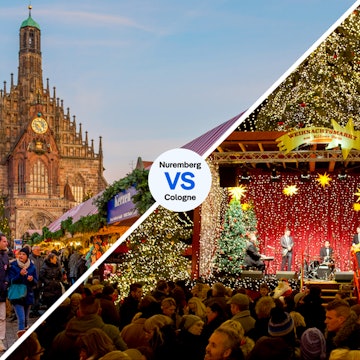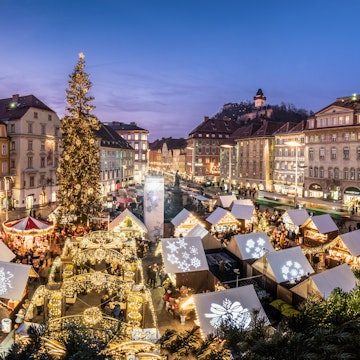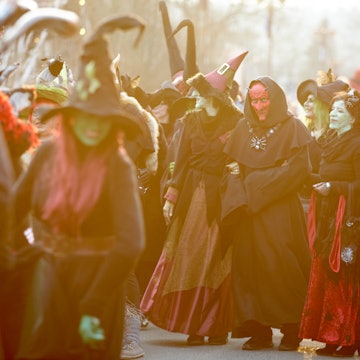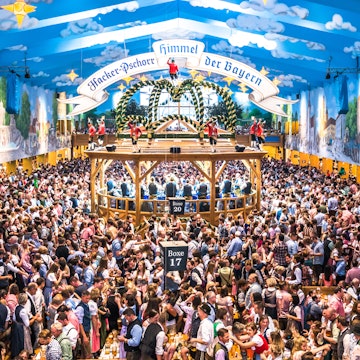

Binz on the island of Rügen in northern Germany. Deutschland Abgelichtet/Shutterstock
Germany’s maritime north keeps a quiet radiance under the radar. Windswept dunes, meandering mud flats and reed cottages sweep across a coastal panorama that’s much less narrativized in Deutschland travel stories – neither pretzels nor Lederhosen in sight (though plenty of beer).
Wherever you go in northern Germany, water is a loyal travel buddy – the coastline extends around 3700km along the North and Baltic Seas. Surprises await in coastal regions such as Hamburg and Mecklenburg–Western Pomerania, as well as on the Baltic Islands where you’ll find Germany’s sunniest area. Yet just a couple of hours away by car or train, landscapes notably shift from wild nature to quaint countryside and lively small-city life.
From countercultural city experiences to medieval town centers, not to mention plenty of delicious food and drink options, this part of Germany has much to entice visitors. These are the best things to do while visiting northern Germany.

1. Discover what’s cool in Germany’s biggest port
Hamburg, Germany’s major port and second-largest city, has a vibe unlike any other maritime European destination. Its alternative culture and nightlife are an unrivaled deep sea of dive pubs and clubs, live music venues, and theaters. You can dance inside a former smugglers’ prison, techno rave bunker or arthouse-inspired industrial boat. Posting up on a barstool until the wee hours might lead you into an underground boxing gym or around Beatles’ nightlife history.
The St Pauli neighborhood, nicknamed the Pirate District, is Hamburg’s famous counterculture stronghold, abounding in graffiti, vintage and vinyl stores, and clean-eating cafes. Visit Flohschanze, the city’s best flea market situated in a former slaughterhouse complex, or, when in season, cheer on FC St Pauli (the German league’s anti-establishment, anti-hooligan football team), joining its unconventional, punk fandom.
Planning tip: On Wednesdays in the late afternoon, head to Spielbudenplatz for the weekly St Pauli Nachtmarkt. Join locals as they relax in the pop-up beer garden and listen to live bands; local artisans sell their wares here, too. From mid-November to December 23, Spielbudenplatz becomes an X-rated Christmas market with lingerie and erotic toy stands, mulled wine and activities like “porno karaoke.”

2. Indulge in northern delicacies
Northern Germany’s prime seafood delicacies include Sylter Royal oysters farmed off the coast of the island of Sylt (Germany’s only spot for native oyster cultivation), North Sea crustaceans such as Nordseekrabben (teeny, hand-peeled brown shrimp) on rye bread or scrambled eggs, and steamed winter mussels in white wine and cream sauce.
The region’s favorite snack is, indisputably, the Fischbrötchen (fish sandwich) – a crusty roll of fish fillet (usually battered and fried cod or pollock, though everything from pickled and smoked herring to salmon is on offer) with traditional toppings like raw onions, pickles, lettuce, horseradish and remoulade sauce.
The German north is also famous for its sweet treats, including Hamburg’s favorite pastry, the Franzbrötchen (lovechild of a cinnamon bun and croissant), and marzipan in Lübeck, the world’s biggest marzipan exporter. Coastal drinking traditions include East Frisian tea rituals and Napoleonic Rotspon red wine served from Hamburg to Rostock.
Planning tip: Want to impress a maritimer? Order Labskaus. The sailor’s stew of potato, cured beef, herring and beetroot is a distinct, northern German classic.

3. Cruise historic waterways
Whether you’re navigating the northern Elbe and Weser rivers on a magnificent cruise ship or punting along on ferries between islands and inland canals, there’s much to enjoy about being on the water. Cruises offer a historic sightseeing experience that can range from local (Hamburg commuter lines shuttling between downtown landmarks for a couple of euros) to scenic and special (sunset rides from Travemünde as you marvel at illuminated warehouses while sipping Sekt [sparkling wine] aboard an old German barge).
In Lübeck, Trave River cruises take you around the Salzspeicher (salt warehouses), offering views of the medieval Old Town. From the waterfront promenades here or in Rostock or Kiel, humming ferries bound for Scandinavia travel up the Kiel Canal, the world’s busiest artificial waterway.
Planning tip: In Hamburg, the commuter ferry Line 62 offers prime Elbe River sightseeing. The ferry takes you from the Fischmarkt terminal station to the Elbphilharmonie pier in about 10 minutes. Service is frequent and all day; cost is a regular, one-way public transport ticket.

4. Visit the Hamptons of Germany
Sylt, Germany’s northernmost island, is considered its Hamptons. The island’s unique maritime architecture – reed-thatched cottages and iconic Strandkorb (wicker-basket, candy-striped beach loungers) – nestle along windswept beaches and cliff-spiked dunes, creating some of Germany's prettiest villages.
German celebs frequent Sylt’s luxury wellness resorts and holiday mansions, but the most universal island experiences offer quaintness and simple pleasures: beachside camping, windy hiking from heathland over elevated dunes, and Germany’s best surf. Enriching things to do include seal-watching tours – especially during the pup birthing season from June to August – barefoot mud walking on the Wadden Sea tidal flats, and Sylt’s world-famous North Sea thalassotherapy – a holistic wellness approach using natural island elements like salt water and seaweed. (Check out the Syltness Center if bathing in sea water and mud is your thing.)
Planning tip: Hotels are limited, so most visitors stay in Ferienwohnungen (holiday apartments). Find one via third-party websites such as the Sylt tourism website or Vrbo.


5. Explore northern Germany’s Baltic Islands
Germany’s handful of Baltic Sea islands are among the country’s best-kept secrets. There’s Rügen, the nation’s largest island, where rugged, natural landscapes have inspired German Romanticism art and literature (a Caspar David Friedrich painting of Jasmund National Park’s chalk cliffs is a highlight). Rügen is a gateway to the smaller Usedom, once nicknamed the Badewanne Berlins (Berlin’s Bathtub) and still Germany’s sunniest spot (though Germany shares the island with Poland).
Hiddensee, a short ferry ride from Rügen, is a rare, ecological paradise. Salty sea breezes and pristine harbors are preserved by an island-wide car ban. Getting around surreal, untouched landscapes is an emissions-free activity as you walk, hike and cycle.
Detour: Take a 1.5-hour journey from Binz (on Rügen) via Stralsund and head to the Darss-Zingst Peninsula through which 60,000 cranes migrate in spring and autumn.

6. Romp along the German Riviera
Northern Germany’s Baltic Sea coast is the German Riviera and a European holiday retreat. The main Riviera stretch, coastal Mecklenburg–Western Pomerania, is a sun-kissed time capsule of the vacation days of Freud and Einstein. Across iconic Baltic Sea resort villages such as Warnemünde (Rostock) and Binz (Rügen island), 19th-century Bäderarchitektur (spa architecture) is the epitome of retro-ornate.
Planning tip: You’ll find the quickest, accessible peek at Bäderarchitektur by strolling the 2-mile, villa-lined Strandpromenade (beach promenade) in Binz (a 3-hour drive from Berlin).

7. Visit Hamburg’s legendary fish market
Hamburg’s rip-roaring Fischmarkt is the perfect excuse to wake up early on Sunday morning (or stay up Saturday night). Some 70,000 visitors descend upon the harbor bazaar for a northern German breakfast of fish sandwiches, fresh-baked Franzbrötchen and strong coffee. Since 1703, the Fischmarkt has been a beloved weekend ritual for seafood grilling and Marktschreier (market criers). Meanwhile, in the Fischauktionshalle (Fish Auction Hall), fun things to do include listening to cover bands as “wake-up entertainment” and drinking at food vendor stalls.
Planning tip: The market is open on Sundays from 5–9:30am, April to October, and 7–9:30am, November to March. Arrive as early as possible. In true German fashion, the Fischmarkt ends punctually. The market is most crowded around 9am – that’s when vendors start slashing prices.

8. Discover northern German brewing
Coastal Germany’s beer is known for being crisp, smooth and refreshing. Across northern pubs and breweries, there’s a strong history of independent regional producers you can discover, including the world-famous Beck's from Bremen, Störtebeker’s nautical-inspired beers from Stralsund and Flensburger pilsner (from Flensburg, of course).
In this part of Germany, medieval port trade encouraged an unfiltered landscape of diverse beer styles for foreign sailors and merchants (unlike in southern Germany, where the purity law has lorded over brewing). The modern result is an exciting, truly creative craft beer scene, especially in cosmopolitan Hamburg. Highlights here include Hamburg's first organic brewery, Wildwuchs, and the Altes Mädchen brewpub, where meals are accompanied by pairings from a beer sommelier.
Detour: On Rügen, take a guided tour of the Rügener Insel-Brauerei craft brewery and sip pours like the award-winning Quadriga (a Champagne-like bière brut) in the beer garden.


9. Marvel at Hamburg’s architectural heights
Razed by WWII bombs, Hamburg’s city center has since largely been rebuilt from scratch. Today’s excellent collection of 360-degree lookout platforms offers soaring modern skylines and poignant historical perspectives.
St Nikolai Church, once the world’s tallest building, remains Hamburg’s highest publicly accessible structure. The church’s spire is all that survives today after the WWII bombing in July 1943. Take an elevator up to the observation tower. Below, explore a vast memorial site that includes St Nikolai’s crypt war museum and courtyard ruins.
Nearby, climb the Hamburg Bunker, a former air-raid shelter, to its free rooftop garden for a summer beer and 360-degree downtown panoramas. Also check out Elbphilharmonie, considered Hamburg’s most exciting modern architectural feat. The concert hall is a striking glass structure built atop a historic brick shipping building next to the UNESCO-listed Speicherstadt, the world’s largest warehouse district. The Elphi’s free-admission panorama viewing platform – reached by taking Europe’s longest escalator known as The Tube – is a must-visit at sunset. If you’ve got time, the acoustical venues boast some of the world’s most innovative, state-of-the-art sound engineering.
Detour: Discover lesser-known WWII history on Rügen island at the Prora Documentation Center. In a seaside concrete block, once envisioned as a workers’ resort, exhibitions explore Nazi-era vacation propaganda against Baltic coastal dunes.

10. Wander medieval Old Towns
The once-powerful Hanseatic League has left behind a legacy of awesome medieval Old Towns across northern Germany. In port cities and villages, each and every Altstadt (Old Town) has its own unique labyrinth of timbered homes, Gothic red-brick buildings and historic market squares across cobblestone lanes.
Strolling aimlessly is the best way to explore these UNESCO-listed areas. (They’re teensy and made for it!) Lübeck, the former Hanseatic League headquarters, tops the list with its famous landmark, the Holstentor. Stralsund, Wismar, and Goslar, each a few hours’ train ride or drive from Hamburg or Lübeck, are also favorites for historic Altstadt eye candy.
Detour: The European Hansemuseum in Lübeck is a must-visit accompaniment to walking through the Old Town. Its state-of-the-art exhibition experience frames the Hanseatic League’s fascinating history from meteoric rise to decline.














